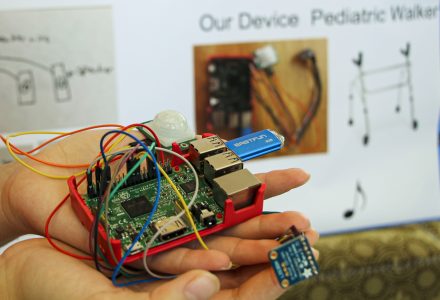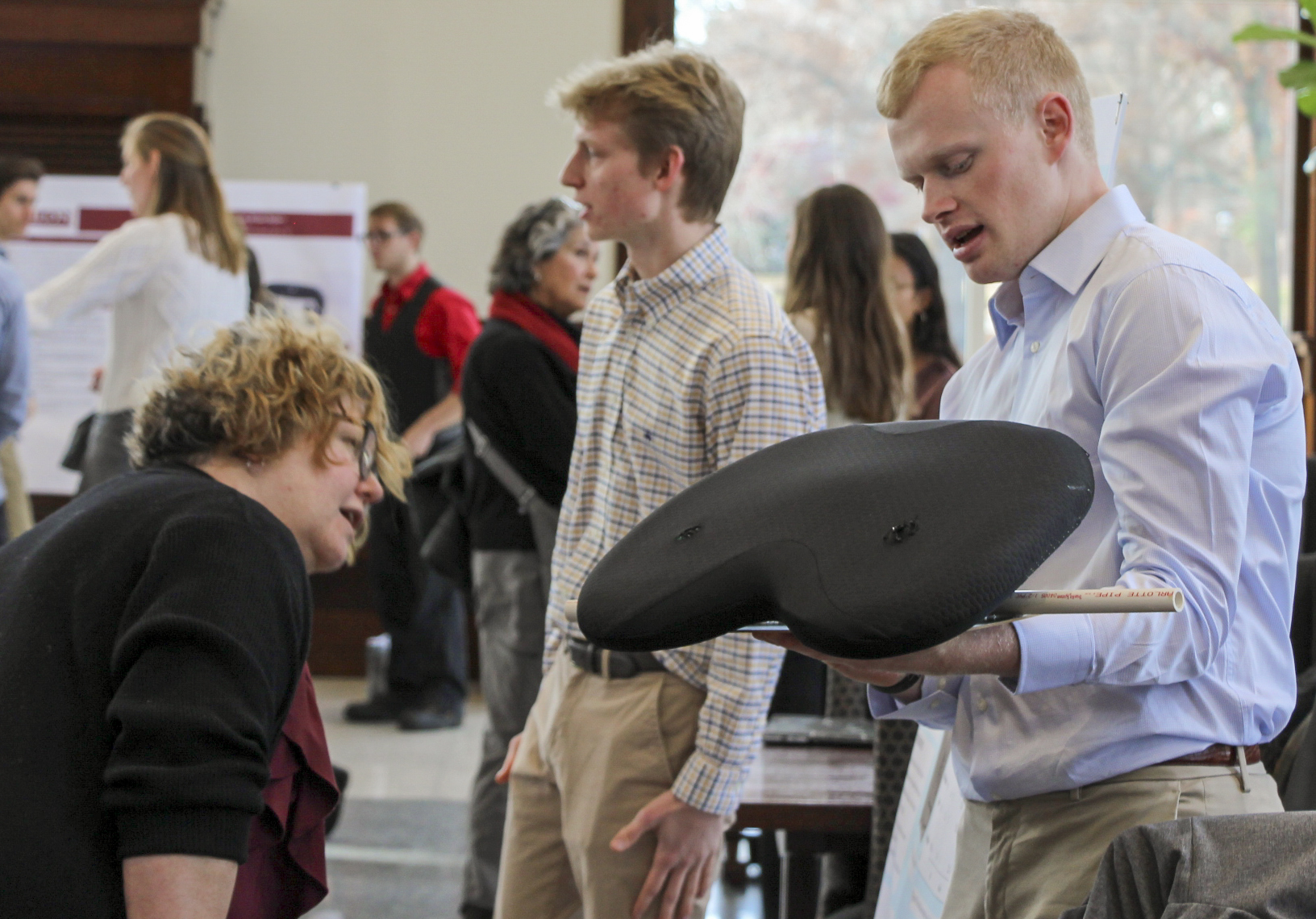Collaboration between the engineering program and the School of Health Sciences' physical therapy program challenged students and brought out their best in service of the community.
Humanity is the engine in engineering.
Evidence of that was found in the outcomes of a first-time collaboration between Elon’s engineering program and the School of Health Sciences on display at Dec. 3’s Global Engagement and Research Forum.
Groups of students in EGR 221: Engineering Design for Service paired with seven clients of the Doctor of Physical Therapy program to design and prototype 11 different devices to improve their mobility and comfort in daily life.
Among those displayed:
-

Sophomore Julia Perline holds the Raspberry Pi motion-activated mp3 player she helped design and program for EGR 221: Engineering Design for Service. A motion-activated mp3 player to encourage a music-loving toddler with cerebral palsy to use her walker. It stops playing songs when the walker stops moving.
- A desk stool that nests a variety of foam cushions for different levels of support and positioning, to alleviate discomfort during a patient’s workday tasks.
- A customized tray-table to allow a girl with limited mobility to do homework and other activities independently.
For engineering students, the course shared by Associate Professor of Engineering Sirena Hargrove-Leak and Associate Professor of Physical Therapy Education Paula DiBiasio was as much about the finished prototypes as the journey to create them.
“In the past, you would build a bridge, and whoever’s was strongest would win,” said sophomore Parker Verlander of some previous engineering assignments. “This was a lot more like what I’d like to be doing: more working with real people and dealing with real-world scenarios that you don’t usually get in class.
“I always enjoyed that, but I don’t think I ever realized that was what I really like. This made me realize it’s what I want to do,” Verlander said.

Each of the seven groups went through a process of interviewing a client or caregivers, learning about a condition or disability, and engineering possible solutions through trial and error — when possible, getting direct feedback from clients.
The gravity of working with people’s immediate needs inspired students to push their limits.
For sophomores Amon Ferrell, Alex Hebert and Julia Perline, that meant long hours learning and creating code to make a Raspberry Pi computer play music by motion or light changes. As they presented last week, they were still discussing code improvements they wanted to make to the device before they were satisfied with the final product.
“This was a lot more like what I’d like to be doing: more working with real people and dealing with real-world scenarios that you don’t usually get in class. This made me realize it’s what I want to do.”
– Parker Verlander ’22
Others embarked on independent research and observation to inform their designs.
Senior Ryan Sienerth and junior Noah Kagan traveled to their client’s workplace to observe him and his physical difficulties bagging items at a register. They developed an adjustable device to hold open shopping bags. Remembering him describe problems with his scooter, they designed a larger, more secure scooter basket able to carry more.

Harry Masker’s and William Tunis’ client struggles with symptoms of Parkinson’s disease that make it difficult for her to stand from a seated position. She told them she’d stopped going out to restaurants and some public places because of it.
Tunis and Masker, sophomores, devised a spring-assisted seat cushion to aid her standing, but they wanted to be sure about their design. Outside of class, they researched Parkinson’s disease. They conferred with a physical therapist at the School of Health Sciences, counseled with DiBiasio, and met a group of Parkinson’s patients to better understand the symptoms and effects of the disease.
“Our initial design would lift them straight up, but we learned that it would be more helpful if it lifted you up and forward at more of an angle,” Masker said.
“That momentum: That’s what physical therapists teach,” DiBiasio said of their design. “It’s strength and coordination from that forward weight shift, from sitting to standing. And they figured that out on their own.”
DiBiasio guest lectured Hargrove-Leak’s course over several weeks in September, teaching students how to interview clients to elicit meaningful responses and how to treat sensitive information. The Global Engagement and Research Forum was the first time she’d seen their designs.
“I believe they spent more time than they originally needed just because they were so invested in the work. Their dedication and commitment to these projects and patients is impressive,” DiBiasio said. “Their level of curiosity, problem-solving, enthusiasm, and professionalism is extraordinary.”
A NEW COLLABORATION

Hargrove-Leak developed the Engineering Design for Service course several years ago, wanting to give students the opportunity to apply their engineering skills to human needs. This is the fourth semester it’s been offered to intermediate-level engineering students. In previous courses, she located clients herself, sometimes relying on word-of-mouth to find them, or allowed students to work with people they knew.
Her collaboration with DiBiasio and the physical therapy program began about a year ago. DiBiasio was looking for cross-disciplinary opportunities when Hargrove-Leak contacted her.
Combining their different areas of expertise, they realized they could create a unique opportunity for students to apply the foundations of engineering to client-driven needs. At the School of Health Sciences, Nita Skillman, who directs the Client and Standardized Patient Program, agreed to gather physical therapy clients willing to participate.
The Center for the Advancement of Teaching and Learning rewarded their collaboration with a mini-grant.
“I think the most phenomenal thing about this class is that they’re having to balance getting great grades with true needs,” Skillman said. “We’ve even had to rein them in. The students truly want to pass these products over to their clients,” which isn’t possible due to costs and medical and legal concerns.
Skillman understands the students’ motivations better than most. She doubled as a client this semester.

Several years ago, Skillman was injured in a wreck. Resulting treatments have left her with leg length discrepancy, making walking very difficult. She graduated from a wheelchair to a walker but must wear orthopedic tennis shoes to balance her gait.
Her challenge to engineering students Shalexzandra Dunkley ’22, Chloe Radigan ’21 and Morgan Sperry ’21: Design a product to offset the leg length discrepancy that can be used with different types of shoes. Over several weeks, the sophomores researched orthopedics and prototyped a system of layered thermoplastics that would adhere to an outsole.
Their idea includes a kit that would allow the user to customize the sole as necessary, depending on the size and shape of the shoe they chose to wear, or the activity they wanted to participate in.
“I am beyond pleased at not only the work of the students, but also at the growth that I’ve seen in them as future engineers. I think they walked away from the experience with a new understanding of the importance of the human connection in engineering.”
Associate Professor Sirena Hargrove-Leak
“They really listened to my needs in their design. They even used a glittery shoe (with the prototype) because I spoke about the need for fashion,” Skillman said. “I also think their product would be affordable, and I loved their idea of being able to purchase a kit to fit to a specific shoe.”
Skillman, DiBiasio and Hargrove-Leak are hopeful that the collaboration will continue in future semesters. They’ve each seen Engineering Design for Service change students.
Stepping away from the crowd at the Global Engagement and Research Forum, Hargrove-Leak watched with pride as her students interacted with the graduate students, medical professionals and faculty that filled the Great Hall.
“I am beyond pleased at not only the work of the students, but also at the growth that I’ve seen in them as future engineers,” she said. “I think they walked away from the experience with a new understanding of the importance of the human connection in engineering.”



